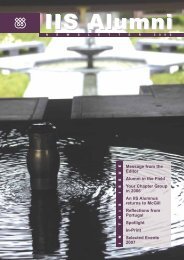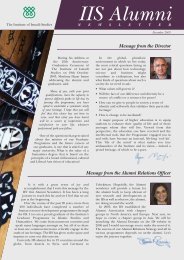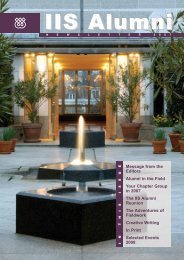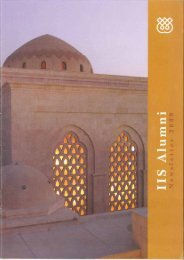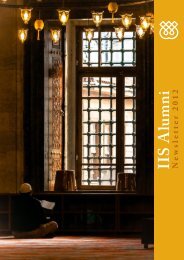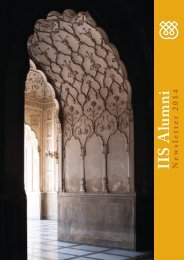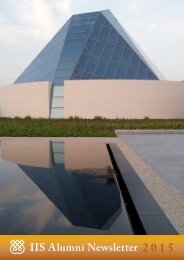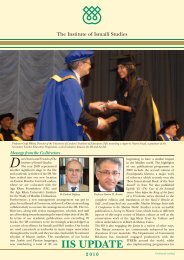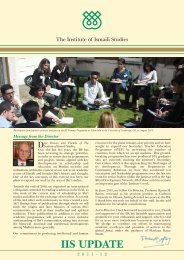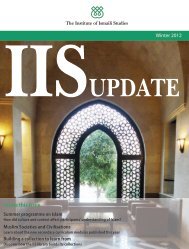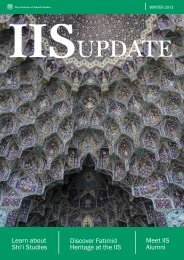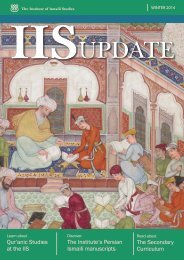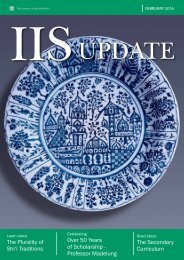IIS Alumni Newsletter 2017
You also want an ePaper? Increase the reach of your titles
YUMPU automatically turns print PDFs into web optimized ePapers that Google loves.
<strong>IIS</strong> <strong>Alumni</strong> <strong>Newsletter</strong> <strong>2017</strong>
MESSAGES<br />
2<br />
CONTENTS<br />
Co-Director’s Message to the <strong>Alumni</strong> Association 2<br />
Message from the <strong>Alumni</strong> Relations Coordinator 3<br />
Chapter Group Meetings 3<br />
The Impact of <strong>IIS</strong> <strong>Alumni</strong> 4<br />
The Concept of Soul in a Sufi-Yogi Dialogue of<br />
17th-Century India 6<br />
Building Bridges 7<br />
Opening of the Aga Khan Centre 8<br />
Music in the Classroom: Using Tunes to Teach 10<br />
Educating for Pluralism through Adopting the UN<br />
Convention on the Rights of the Child (UNCRC) 11<br />
The 2nd International Ismaili Studies Conference:<br />
An Overview 11<br />
<strong>Alumni</strong> Community Portal 12<br />
Before the Printed Word: Texts, Scribes and Transmission –<br />
A Symposium on Manuscript Collections Housed<br />
at The Institute of Ismaili Studies 14<br />
Internship Experience 14<br />
Journey with Muhammad 15<br />
Diaspora and Media in Europe:<br />
Migration, Identity, and Integration 15<br />
The Fatimids: The Rise of a Muslim Empire 16<br />
The Fatimid Caliphate: Diversity of Traditions 16<br />
Insight from the Author of Remember Who You Are 16<br />
Publications, Papers and Presentations 17<br />
MESSAGE FROM THE CO-DIRECTOR<br />
Dear <strong>IIS</strong> <strong>Alumni</strong><br />
This year marks the 40th anniversary of<br />
the establishment of The Institute of Ismaili<br />
Studies as well as the Diamond Jubilee<br />
of His Highness’ accession to the Ismaili<br />
Imamat. Over the past four decades, the<br />
<strong>IIS</strong> has made significant contributions to<br />
scholarship and learning, particularly in the field of Ismaili<br />
and broader Shi‘i studies. It has also been instrumental in<br />
preserving and studying Ismaili intellectual heritage as well<br />
as in developing educational and human resources to serve the<br />
needs of the global Ismaili community. To mark this important<br />
milestone, the Institute hosted a commemorative lecture<br />
at the Ismaili Centre, London, and organised a special<br />
40th-anniversary celebration, with Prince Rahim Aga Khan as<br />
the guest of honour.<br />
I am delighted to inform you that the Graduate Programme in<br />
Islamic Studies and Humanities (GPISH) will be validated by<br />
the School of Oriental and African Studies (SOAS), University<br />
of London (UCL), from 2019. The Secondary Teacher Education<br />
Programme (STEP) results in two post-graduate awards: The Post<br />
Graduate Diploma (PgDip) component is awarded by UCL, and<br />
from September 2019, the MA component will be validated and<br />
awarded by SOAS University of London.<br />
In <strong>2017</strong>, we held a symposium entitled “Before the Printed Word:<br />
Texts, Scribes and Transmission”, which was the first of its kind<br />
organised by the <strong>IIS</strong>. Scholars with manuscript expertise, who<br />
have either contributed directly to our manuscript analysis<br />
project or worked with the <strong>IIS</strong> and other similar manuscript<br />
repositories, shared their findings and insights.<br />
Last year, we also organised a roundtable on “Approaching<br />
Religious Texts in Early Islam: The Sanaa Qur’an Palimpsest as<br />
Example” that brought together five scholars of the Qur’an and<br />
early Islamic documents. The roundtable included discussions<br />
on and critiques of a number of methodological issues raised<br />
by Dr Asma Hilali in her book The Sanaa Palimpsest: The<br />
Transmission of the Qur’an in the First Centuries AH, as well as<br />
the main results and hypothesis related to her interpretation of the<br />
palimpsest and the use of the palimpsest by its contemporaries.<br />
This year, we have launched the World of Islam series of<br />
publications with Dr Shainool Jiwa’s The Fatimids: 1. The<br />
Rise of a Muslim Empire in print, e-book and audiobook<br />
formats. This new series has been created for a non-specialist<br />
audience to provide engaging introductions to historical,<br />
cultural, social and religious topics that explore the rich<br />
diversity of Islam. Aimed at Muslim and non-Muslim readers<br />
alike, these accessible books are intended to kindle deeper<br />
interest in and to stimulate non-specialist audiences to think<br />
differently about Islam.<br />
In all of our work, <strong>IIS</strong> alumni continue to play a significant<br />
role. More than a third of our professional staff comprises <strong>IIS</strong><br />
graduates, including several heads of departments and units.<br />
The symbiotic relationship between the <strong>IIS</strong> and its graduates<br />
is very important. To strengthen this connection, we have<br />
launched the <strong>Alumni</strong> Community Portal, which offers a range<br />
of exciting opportunities for you to learn, share and connect<br />
fellow alumni and your alma mater.<br />
I thank you for your continued support and engagement.<br />
With best wishes for success in all your endeavours.<br />
Dr Farhad Daftary
MESSAGE FROM THE ALUMNI<br />
RELATIONS COORDINATOR<br />
It is with great pleasure that I write<br />
to you as the <strong>Alumni</strong> Relations<br />
Coordinator. I must thank my<br />
predecessor Shellina Karmali for<br />
her nine years of contributions to<br />
the <strong>IIS</strong>, including to the <strong>Alumni</strong><br />
Relations Unit. During her tenure,<br />
Shellina worked to strengthen the<br />
connection between the <strong>IIS</strong> and its alumni, and I am<br />
committed to building on her achievements.<br />
This issue of the <strong>Alumni</strong> <strong>Newsletter</strong> includes a snapshot<br />
of the significant impact of our alumni. The data for this<br />
impact study was obtained via the survey conducted in<br />
December <strong>2017</strong>, and I am pleased to report that more<br />
than 90% of alumni participated in the survey. So, a big<br />
thank you to all those who contributed to the <strong>Alumni</strong><br />
Impact Survey <strong>2017</strong>.<br />
The <strong>IIS</strong> <strong>Alumni</strong> Association is now more than 600<br />
alumni strong, dispersed across more than 30 countries.<br />
With the launch of the online <strong>Alumni</strong> Community<br />
Portal, we are trying to make it easier for you to stay<br />
connected with the Institute and with each other. The<br />
portal offers search functionality, enhanced privacy<br />
settings, and the ability to link your social networking<br />
and personal websites to your profile. Also, we are<br />
providing regular updates on events such as conferences,<br />
book launches, online learning courses, and fellowship<br />
and job opportunities.<br />
For the upcoming Global Reunion 2018, the <strong>Alumni</strong><br />
Portal provides access to important information. If you<br />
have not yet activated your account, I urge you to do<br />
so by visiting https://iisalumni.org, as this is the official<br />
communication platform for all of us to stay connected.<br />
My colleague Malika Pallaeva, who has recently joined<br />
the <strong>Alumni</strong> Relations Unit, and I look forward to<br />
engaging with you and supporting you in your continued<br />
professional development. Please let us know how we<br />
can serve the <strong>IIS</strong> alumni community more effectively.<br />
You can write to us at alumni@iis.ac.uk and share with<br />
us your comments and suggestions. We look forward to<br />
hearing from you soon!<br />
Finally, I would like to take this opportunity to welcome<br />
the new alumni and to wish them the very best as they<br />
begin their careers.<br />
Congratulations!<br />
Sabeen Bashwani<br />
<strong>Alumni</strong> Relations Coordinator<br />
CHAPTER GROUP MEETINGS<br />
The annual chapter group meetings were held in:<br />
a) Kuala Lumpur (for the Asian Chapter Group), on ‘Arts and<br />
Architecture in South Asia’. James Bennett, Professor Jimmy Lim,<br />
Professor Mohamad Tajuddin Mohamad Rasdi, Fayaz Alibhai<br />
and Dr Shiraz Kabani delivered presentations at this meeting,<br />
which was attended by thirty-three alumni from across Asia.<br />
Representatives from the leadership of the Ismaili Community in<br />
the Far East were also invited to address and interact with alumni.<br />
b) London (for the European Chapter Group), on ‘Identity in<br />
Contemporary Europe: a Case Study of Islam’. Thirty-five<br />
alumni participated in panel discussions, symposium, and<br />
Q&A sessions. Yasmin Alibhai-Brown, Sabrina Mahfouz,<br />
Dr Lynn Revell, and Professor Frances Stewart delivered<br />
presentations at the meeting. In addition, the President and<br />
Vice President of the National Council as well as Chairmen<br />
of ITREB UK and Aga Khan Foundation UK joined the <strong>IIS</strong><br />
Head of Community Relations to discuss how <strong>Alumni</strong> can<br />
play a role in collaboration with AKDN and Jamati Institution.<br />
c) Fez (for the North American Chapter Group), on ‘[The] Sacred<br />
and Water in World Religions with Special Reference to Islam,<br />
Shi’ism, and Sufism’. This meeting was attended by 57 alumni<br />
from across North America, who were also able to attend part of<br />
the Sacred Music Festival taking place concurrently. Dr Nargis<br />
Virani, Dr Alessandro Cancian, Tanya Panjwani and Dr Shiraz<br />
Kabani (via video) delivered presentations at the meeting.<br />
ASIAN CHAPTER GROUP<br />
EUROPEAN CHAPTER GROUP<br />
CHAPTER GROUP MEETINGS<br />
NORTH AMERICAN CHAPTER GROUP<br />
3
THE IMPACT OF <strong>IIS</strong> ALUMNI<br />
THE IMPACT OF <strong>IIS</strong> ALUMNI<br />
Hussein Faruque Aly<br />
Class of GPISH 2004<br />
Over the past 35 years since the <strong>IIS</strong> has offered post-graduate<br />
courses, over 600 individuals have benefited from its generous<br />
scholarships and have graduated from various iterations of the<br />
<strong>IIS</strong>’ programmes. These include the following:<br />
(a) Implemented in 1980, the Waezeen and Teacher Education<br />
Programme (WTEP) was aimed at furnishing students with<br />
knowledge of the history and philosophy of Ismaili Muslims<br />
within the larger context of the Islamic tradition.<br />
(b) In 1982, the <strong>IIS</strong> sponsored 11 students to undertake an<br />
advanced curriculum-planning programme at the University<br />
of London’s Institute of Education (IoE), the purpose of<br />
which was to train human resources to develop the <strong>IIS</strong>’<br />
primary-level Ta‘lim curriculum.<br />
(c) During the 1980s, the <strong>IIS</strong> collaborated with McGill University<br />
on a joint programme leading to an MA in Islamic Studies.<br />
(d) The Graduate Programme in Islamic Studies and Humanities<br />
(GPISH) was launched in 1994 as an inter-disciplinary<br />
programme, focussing on the faith, thought and culture<br />
of Muslim societies in both historical and contemporary<br />
contexts. The three-year programme acts as both preparation<br />
for a research degree and as a stepping-stone to a variety of<br />
career opportunities around the world.<br />
(e) The Secondary Teacher Education Programme (STEP)<br />
was founded in 2007 with a view to developing educators<br />
to teach the Institute’s Secondary Curriculum. It consists<br />
of two awards: an MA in Education, Muslim Societies and<br />
Civilisations, and a Post Graduate Diploma (PGDip) in<br />
Teaching and Reflective Practice.<br />
All of these post-graduate programmes shared the common<br />
goal of developing individuals who could help to address issues<br />
of contemporary relevance to Muslim societies and, more<br />
particularly, who could bring relevant knowledge to bear on the<br />
work of the institutions of the Ismaili Imamat and the community.<br />
Individually, many graduates of these programmes have done<br />
impressive work. However, when we look at their contributions<br />
as a whole, it paints an even more exciting picture. The<br />
following charts provide a snapshot of the alumni body and<br />
their contributions.<br />
ALUMNI LOCATION<br />
FIELD OF WORK<br />
Australia 1%<br />
Africa 3%<br />
Central Asia 9%<br />
Europe 19%<br />
Far East 1%<br />
Middle East 4%<br />
North America 42%<br />
South Asia 21%<br />
Governance 8%<br />
Arts 2%<br />
Tech 2%<br />
ECD 2%<br />
Law 2%<br />
Health 4%<br />
Other 2%<br />
Management/Business 14%<br />
Education 51%<br />
Social Development 13%<br />
ALUMNI BY EMPLOYMENT ORGANISATION<br />
4<br />
International/Bilateral Orgs 1%<br />
National Council 1%<br />
Seeking Opportunities 8%<br />
Retired 2%<br />
Civil Society Org. 2%<br />
Civil Service/Government 2%<br />
Academia 8%<br />
Tech 1%<br />
Private Sector 7%<br />
<strong>IIS</strong> 9%<br />
AKDN 7%<br />
ITREB 52%
ALUMNI IMPACT<br />
The following is a graphic representation of the contributions of our alumni since graduating<br />
from the <strong>IIS</strong>. Statistics depicted below are self-reported indicators of impact. The categories<br />
and figures have not been normalised, but they are a high-level indicators of the breadth and<br />
scope of the impact of <strong>IIS</strong> alumni.*<br />
82<br />
MONOGRAPHS<br />
Over<br />
100,000<br />
Secondary<br />
PUBLICATIONS<br />
69 192<br />
edited volumes<br />
COURSES AND STUDENTS<br />
articles in academic journals<br />
Over<br />
Over<br />
30,000 2,000<br />
Primary Early Childhood<br />
734<br />
articles in print or in online journals<br />
Over<br />
700<br />
COURSES TAUGHT AT TERTIARY<br />
LEVEL TO NEARLY<br />
44,000 STUDENTs<br />
THE IMPACT OF <strong>IIS</strong> ALUMNI<br />
274<br />
BY HIS HIGHNESS<br />
251<br />
within<br />
Ismaili Community<br />
Institution and AKDN<br />
APPOINTMENTS<br />
129<br />
within<br />
boards of<br />
external organisations<br />
AWARDS<br />
262<br />
alumni received awards,<br />
grants or recognition<br />
FILMS AND EXHIBITIONS<br />
79<br />
curated exhibitions<br />
91<br />
DOCUMENTARIES/<br />
FILMS PRODUCED<br />
Nearly<br />
9,000<br />
LECTURES DELIVERED<br />
IN NON-ACADEMIC SETTINGS<br />
LECTURES OR CONFERENCE<br />
PRESENTATIONS<br />
Over<br />
presentations at academic<br />
900 conferences<br />
TKN<br />
128 alumni<br />
served nearly<br />
9,000<br />
DAYS<br />
*<br />
Based on 552 alumni responses<br />
5
ARTICLES BY ALUMNI<br />
6<br />
THE CONCEPT OF SOUL IN<br />
A SUFI-YOGI DIALOGUE OF<br />
17TH-CENTURY INDIA<br />
Perwaiz Hayat<br />
Class of McGill 1987<br />
The present essay 1 focuses on the subject of soul and is based<br />
on the text traditionally known as Su’āl va Javāb – a transcript<br />
of an intellectual discussion between the Mughal crown prince<br />
Dārā Shikōh (or Dārā Shukōh) 2 and a Hindu yogi Lāl Dās 3<br />
during the 17th century CE. 4<br />
Dārā begins the discussion by asking: If ātman (individual soul)<br />
and the paramātman (supreme soul) are the same in nature,<br />
how then does the supreme soul become an individual soul and<br />
again how can the same individual soul become the supreme<br />
soul? The question is principally about the spiritual voyage –<br />
the individual soul leaving its origin and then returning to unite<br />
with its origin. Lāl Dās elaborates his reply with the example<br />
of alcohol: due to impurities, clear water becomes alcohol; only<br />
after removing all the impurities does it become clear water<br />
again. Thus, a polluted individual soul cannot become one with<br />
the supreme soul unless it removes its impurities to become<br />
clear and clean.<br />
In further exploring the relationship between the individual<br />
soul and the supreme soul, Dārā asks Lāl Dās: “If there is<br />
no difference, then, how do reward and punishment come<br />
into being?” Lāl Dās replies that “it is due to the effect of the<br />
container.” He illustrates this with the example of the water<br />
that flows in the Ganges and the water of the Ganges held in<br />
small containers. He explains to Dārā that it is due to the nature<br />
of the Ganges, that is, its vastness, purity and connection to<br />
Shiva, which makes the Ganges river different from the water<br />
of Ganges held in small containers.<br />
The Ganges is believed by many Hindus to be pure and purifying.<br />
Lāl Dās suggests that the water of the Ganges remains pure<br />
until it is flowing in the Ganges River, and the question of good<br />
and bad does not exist. However, if a small quantity of the water<br />
of the Ganges is held in a container (apparently not connected<br />
with Shiva), it can easily become contaminated. Similarly,<br />
Lāl Dās notes, the supreme soul is pure like the water in the<br />
Ganges River, without impurities, and is a liberator (mukhalliṣ),<br />
whereas the individual soul becomes contaminated during its<br />
voyage and remains imprisoned in existence. As such, it will<br />
commit acts – good and bad – for which it will be rewarded<br />
and punished. To escape the cycle of good and bad, reward and<br />
punishment, the individual soul needs to reconnect with the<br />
supreme soul, transcending the world of existence, and leaving<br />
the prison of time and space.<br />
Dārā moves on to the next set of questions and raises the<br />
issue of pain and pleasure. Here the discussion begins with<br />
the relationship of the soul with the body and the connection<br />
of the individual soul with the supreme soul. Dārā questions<br />
why there should be pain and pleasure, given that an individual<br />
soul is in fact part of the supreme soul. Lāl Dās’s reply is<br />
consistent: the reason for such feelings is that the individual<br />
soul is imprisoned in the body. Thus, whatever the body feels,<br />
it transmits to the soul. Similarly, as a companion to the body,<br />
whatever the soul feels, it conveys to the body. However, in the<br />
presence of “perfect fuqrāʼ”(sing. faqīr; perfect faqīr according<br />
to the Indian Sufi literature is a Sufi master), 5 the individual soul<br />
remains awake and content. Due to that vigilance, the nature of<br />
the individual soul leaves existence behind and, after losing its<br />
“illusionary or imaginative aspect”, becomes the supreme soul<br />
and transcends the feelings of pain and pleasure. A similar idea<br />
can be found in Ismaili Ginans. For instance, Imam Begum, a<br />
well-known Ginan composer of the Indian Subcontinent, sings:<br />
“When I found the true master, miseries were gone and the<br />
problems of this servant were resolved; I achieved happiness.” 6<br />
Thus, the individual soul is essentially as pure and blameless<br />
as the supreme soul. However, the individual soul becomes<br />
contaminated during its voyage and is imprisoned. The<br />
individual soul that is too occupied in self-serving activities<br />
will be condemned to multiple rebirths and will remain captive<br />
in the cycle of being born 84 times from womb to womb. Only<br />
when it remembers the words of the “Perfect Master” will it<br />
become conscious of its identity and recognise that it is a part<br />
of the supreme soul. At that point, it will no longer have any<br />
inclination towards worldly temptations and wishes but will be<br />
a purified soul ready to return to its origin. According to Lāl<br />
Dās, such a soul will not face judgement because it is pure. 7<br />
1<br />
This short essay is based on the paper presented at the Oxford Symposium on Religious<br />
Studies held on 15, 16 and 17 March <strong>2017</strong> in Oxford, UK.<br />
2<br />
Perwaiz Hayat, “Dārā Shikōh”, in Encyclopedia of Religion, vol.4, 2nd ed. (New York:<br />
Macmillan Reference, 2005), 2218-2220.<br />
3<br />
Dārā introduces Bābā (i.e., Lāl Dās) in his famous work Hasanāt ul-‘Ārifīn with the<br />
following words: “Bābā Lāl Mundiyya who is amongst the perfect Gnostics – I have<br />
seen none among the Hindus who has reached such ‘irfān and spiritual strength as<br />
he has.” See Dārā Shikōh, Hasanāt ul-‘Ārifīn, ed. Sayyid Makhdoom Rahin (Tehran:<br />
Chāpkhāna-i Wāhīd, 1352 H. Solar), 49.<br />
4<br />
Though neither written nor compiled by Dārā himself, Su’āl va Javāb stands as a unique<br />
work. It is unique in the sense that never before under the Mughals had such an exercise<br />
been undertaken by any royal for the sake of gaining knowledge. This essay is based<br />
on various manuscripts of the text – specifically on the manuscript C identified as Su’āl<br />
va javāb Dārā Shikōh va Bābā Lāl Dās, in manuscript Or. 1883, India Office Library<br />
Collection, British Library, and a few secondary sources available.<br />
5<br />
For example, see Sultan Bahu, Kitāb ‘Aynul Faqr (Lahore: Nawal Kishore Printing Press, 1906).<br />
6<br />
“Satgur milyā tiyāre dukhaj tarriyāji; sarvey sāriyā dāsi nā kāj; Anand hoon pāmi.” See G.<br />
Allana, Ginans of Ismaili Pirs, vol.1 (Karachi: Ismaili Association for Pakistan, 1984), 326-27.<br />
7<br />
For a complete edited text and translation of manuscript C, refer to Perwaiz Hayat, ‘The<br />
conversation between Dārā Shukōh and Lāl Dās: a Șūfī-Yogī dialogue of the 17th-century<br />
Indian subcontinent’, PhD thesis, McGill University (Montreal, April 2016): http://digitool.<br />
library.mcgill.ca/webclient/StreamGate?folder_id=0&dvs=1527843140980~216.
BUILDING BRIDGES 1<br />
Jan-e-Alam Khaki<br />
Class of WTEP 1983<br />
Building bridges and removing walls characterise our times,<br />
despite some gaps. Enormous efforts are being made by various<br />
organisations and individuals to help build bridges among<br />
communities and cultures, notwithstanding the thesis of the<br />
clash of civilisations.<br />
It is time to remove walls that obstruct human communication,<br />
flow of information, knowledge and wisdom from crossing<br />
borders and boundaries. The times are gone when communities<br />
were cocooned in their villages or towns. My parents’<br />
generation, for example, hardly saw a city, let alone another<br />
country. Today, I, like many others, have travelled to countless<br />
cities and more than two dozen countries. My son, in his 30s,<br />
has so far travelled to twice the number of countries that I have<br />
visited, and he is only half my age. His children may travel even<br />
beyond the limits of the earth.<br />
If such is the pace and possibility of journeys across countries<br />
and continents, what does this mean in terms of our way of<br />
looking at the world and our attitude towards its people? Could<br />
we still cherish our self-centred, self-righteous, and narcissist<br />
attitudes that helped us survive in small ‘ponds’ while we<br />
today swim in big ‘oceans’? What does the spirit of our time<br />
(zeitgeist) demand?<br />
In my view, in order for us not just to survive but to thrive,<br />
we need to build bridges across frontiers, languages, cultures<br />
and perspectives. We need to learn to live with, rather than<br />
live away from, the ‘difference’ with the ‘other’. The attitude<br />
of bridge-building is an appropriate response to, and skill for,<br />
living with difference.<br />
It is time to remove the walls that impede communication.<br />
A physical bridge is an overarching structure across a gap, such<br />
as a river, or even a long ditch between, say, two villages. It<br />
enables people to connect two separate spaces which otherwise<br />
are directly inaccessible to each other. A bridge is built step<br />
by step, plank by plank, raising the level of the bridge. Once<br />
built, people and vehicles access what is otherwise inaccessible.<br />
Likewise, used in a metaphorical sense, bridge-building can<br />
entail connecting different cultures, peoples and ideas across<br />
civilisations, revisiting our own ideas about them and trying to<br />
understand their worldviews on their terms; approaching them<br />
as they are, not as they should be.<br />
Cultures and civilisations are enriched not by being the same<br />
but by being different.<br />
Great philosophers, poets, mystics, scientists and artists often<br />
build bridges when they promote cross-cutting themes through<br />
their ideas, inventions, concepts, artefacts, poetry and literature<br />
that often have universal appeal. They interpret human<br />
conditions in a way that transcends boundaries and creates more<br />
space to allow others to come in and enable insiders to access<br />
what is outside a closed system, cultural or philosophical, as<br />
Plato rightly exemplifies in his cave metaphor.<br />
For example, the inspired messages of the prophets, mystics,<br />
poets, scientists and philosophers like Socrates, Aristotle, Ibn<br />
Sina, Maulana Rumi, Allama Iqbal, Shakespeare, Shaikh Sa‘di,<br />
Tagore and Newton are amongst the few who have international<br />
appeal across geographical boundaries, regardless of whether<br />
or not people agree with their thoughts.<br />
To illustrate this, a verse from the great poet Sa‘di, best known<br />
for his Gulistan and Bustan, is cited here which emphasises<br />
the unity of mankind and their interdependence. The verse has<br />
been placed at the entrance of the UN building in New York.<br />
In the verse, Sa‘di says that the sons of Adam are akin to the<br />
limbs of one organic body, as they have been created from one<br />
essence. When an ailment afflicts a part of the body, the other<br />
parts cannot remain restful. If you are unconcerned about the<br />
troubles of others, you do not deserve to be called ‘human’.<br />
Means of communication and travel, such as planes, trains and<br />
other means of transport, do the same today — connect people<br />
from distant lands to the remotest villages and towns. The<br />
stretch of this physical bridge-building is so great that today the<br />
means of transport are connecting us to distant planets in the<br />
heavens. Modern movies and dramas similarly pick up ideas<br />
that connect many cultures and people who often do not see<br />
eye to eye with each other. Similarly, electronic communication<br />
methods, such as email and social media, mean that, despite its<br />
limitations, today’s world aims to connect and integrate.<br />
Four terms characterise the metaphorical bridge-building: shared<br />
aspirations, integration, connectivity and inclusiveness. These are<br />
some of the great planks with which we can build the longest and<br />
strongest bridges reaching out to what is otherwise unbridgeable.<br />
We all, in sum, need to be involved in bridge-building across<br />
communities by sharing with, and learning from, each other.<br />
Communities and individuals unwilling to build bridges today<br />
are likely to remain isolated tomorrow. Bridge-building today,<br />
indeed, is future-building.<br />
ARTICLES BY ALUMNI<br />
1<br />
First published in Dawn, September 22nd, <strong>2017</strong>: https://www.dawn.com/news/1359283/building-bridges<br />
7
AGA KHAN CENTRE<br />
OPENING OF THE AGA KHAN CENTRE<br />
On 26 June, His Royal Highness the Prince of Wales<br />
inaugurated the Aga Khan Centre in the presence of His<br />
Highness the Aga Khan. Among the guests were the Mayor<br />
of London, Sadiq Khan and the Minister of State for the<br />
Commonwealth and United Nations, Lord Ahmad.<br />
To mark this historic occasion, His Highness the Aga Khan was<br />
joined by his family. Expressing great pride in the opening of<br />
the Aga Khan Centre he said:<br />
“We celebrate today a beautiful new<br />
architectural accomplishment. As we do<br />
so, we also honour those who have made<br />
this Centre possible – and the values that<br />
have inspired their work. Two of those<br />
values which deserve special mention<br />
today – the value of education as a force<br />
for cooperation and healing in our world –<br />
and the value of architecture as a source<br />
of inspiration and illumination.”<br />
Echoing his words, His Royal Highness, the Prince of Wales<br />
commented that the Centre will make a profound difference<br />
for our future generations, who will gain a better appreciation<br />
of the intellectual and cultural contributions that Islamic<br />
civilisations have made to our world.<br />
The Aga Khan Centre is a place of education, knowledge, cultural<br />
exchange and insight into Muslim civilisations. Designed by<br />
Maki and Associates, led by Fumihiko Maki - one of Japan’s<br />
most distinguished contemporary architects - the Centre provides<br />
a new home for The Institute of Ismaili Studies (<strong>IIS</strong>), the Aga<br />
Khan University Institute for the Study of Muslim Civilisations<br />
(AKU-ISMC) and the Aga Khan Foundation UK (AKF UK).<br />
These institutions have been operating with the mandate to<br />
increase knowledge and understanding of Muslim civilisations<br />
and help improve the quality of life for people around the world.<br />
The Centre is designed to represent the values of openness,<br />
dialogue and respect for different viewpoints (pluralism). A<br />
distinctive feature of the Aga Khan Centre are its six gardens,<br />
courtyards and terraces inspired by Islamic landscape design from<br />
Spain, North Africa and the Middle East to Central and South Asia.<br />
8
AGA KHAN CENTRE<br />
The Centre is primarily designed for an academic community,<br />
with places for students, scholars and staff to share ideas and work<br />
together alongside flexible teaching spaces and quiet research areas.<br />
The Aga Khan Library, London, houses the collections of the <strong>IIS</strong><br />
and AKU-ISMC, providing spaces for the collections, study and<br />
secure archival storage for rare books and manuscripts.<br />
Members of the public will be able to visit the building and<br />
explore the gardens from 22 September 2018.<br />
www.akdn.org/speech/his-highness-aga-khan/opening-agakhan-centre-london<br />
www.princeofwales.gov.uk/speech/speech-prince-walesopening-aga-khan-centre-kings-cross-london<br />
9
ARTICLES BY ALUMNI<br />
MUSIC IN THE CLASSROOM:<br />
USING TUNES TO TEACH 1<br />
Zohra Surani<br />
Class of STEP 2014<br />
They say the music you listen to defines you. Whether this is<br />
true or not, music plays a significant role in our lives. Music can<br />
soothe a crying baby, calm a disturbed mind, and even simply<br />
give us company on morning walks and long commutes.<br />
Today, let’s focus on the value of music in the field of education,<br />
where it has become an essential teaching tool. In my Religious<br />
Education (RE) classrooms, I find that music can have a positive<br />
impact on student behaviour. Dr Frances Rauscher discovered<br />
in her research on music cognition that “music stimulates<br />
thought processes and enhances spatial reasoning, which are<br />
essential for academic success”. Whether it is background<br />
music, slow songs, songs with visuals, and musical videos<br />
which have words and images; all of them can enhance the<br />
classroom environment and boost students’ engagement during<br />
lessons. Different types of music, different rhythms serve<br />
different purposes, and the teacher can choose according to the<br />
topic and use music to evoke emotions and provoke students’<br />
thoughts in the classroom. Below are some of the ways we use<br />
music in the RE classrooms.<br />
Music stimulates students’ attention<br />
in the classroom<br />
In disruptive classrooms, music calms students and is swiftly<br />
able to draw their attention. When I play music, the class goes<br />
silent as the song starts and the students’ eyes focus on the front<br />
of the classroom. Noisy students start shushing others to make<br />
them quiet, and you can see a definite shift in their behaviour.<br />
This made me realise the power of music in the classroom to<br />
stimulate students’ active participation.<br />
One student, Arman, echoes this discovery. “Songs give<br />
us energy, help us enjoy and make the class so interesting<br />
that we listen attentively,” he said. Once you get that elusive<br />
treasure of students’ attention, then it becomes easier to direct<br />
their energies on any task. They become like clay ready to be<br />
moulded in their journey of learning.<br />
Anizka, another student, reiterates, “Songs keep me going and<br />
continuously help me stay focused on a task”. Music creates<br />
a conducive learning environment in the classroom providing<br />
students with inspiration and motivation to focus on the<br />
curriculum.<br />
Music is a valuable gift for teachers giving them the considerable<br />
blessing of students’ attentive thinking, understanding and<br />
learning. One of the reasons that songs may be effective is that<br />
students can easily connect with them, which activates their<br />
brains and motivates them to perform better. Music has the<br />
capacity to grab students’ interest, creatively engage them, and<br />
transform their experience to accelerate the learning process.<br />
Music makes difficult concepts easy to grasp<br />
Music not only helps students learn, but also helps teachers<br />
teach. Music does wonders while teaching abstract concepts that<br />
are challenging to comprehend. Discussions in RE classrooms<br />
often centre around intangible ideas, such as God and how<br />
we can connect with Him; the purpose of our existence or the<br />
significance of faith in our lives.<br />
Alisha, a student, found that songs like Ali mawla Ali mawla,<br />
and Khwaja mere khwaja “evoked feelings within me and<br />
helped me understand my faith better as the wordings in these<br />
songs are so heart-touching and pure”. These devotional songs<br />
draw students’ attention, engross them in deep reflection and<br />
keep them on-task.<br />
Tunes help students connect emotionally while lyrics allow<br />
them to cognitively understand and reflect on the meaning.<br />
Songs compliment the topic and simplify the text as student<br />
Soha says, “Some of the lyrics of the songs have a very good<br />
message and are simple in comparison to reading a text in<br />
which we see a lot of difficult words and so it gets hard.”<br />
When accompanied with the teacher’s direction, debrief<br />
and discussion, songs make truly effective teaching tools.<br />
Discussions allow the students to engage with lyrics and, most<br />
importantly, help them connect with the topic. Therefore, music<br />
is a rich resource when used in the right way.<br />
Music helps memory<br />
Songs are not only effective while teaching, but also help<br />
students retain the information for a longer duration. Songs<br />
are like stories told in a musical way, which makes it easier to<br />
understand the topic and therefore remember it better. While<br />
reviewing learning from previous classes, one of the first things<br />
students remember are the videos or the songs they saw and<br />
heard, and it becomes easy to recall the topic taught, why the<br />
song was used, what they learned from it and what the main<br />
theme was.<br />
Shanaya, a student, says, “The song from the movie PK<br />
[bhagwan hai kahan re tu] has a lot of meaning and visually<br />
the video is so strong which makes me feel that such songs are<br />
a good way of memorising and learning things.”<br />
Songs create lasting impressions in our brains, help in learning<br />
and recollecting the topic. Some students find learning with<br />
songs so helpful that they “make a tune for the answers and<br />
remember them as it makes the topic interesting” as Armaan<br />
does, enthused by the learning process.<br />
Apart from using songs to make the topic engaging, it is useful<br />
for assessment as well. Students create a variety of devotional<br />
songs, qawwali or raps demonstrating their learning, which<br />
also helps them remember the key ideas for longer.<br />
10<br />
1<br />
First published in The Ismaili Magazine, India, December <strong>2017</strong>
EDUCATING FOR PLURALISM<br />
THROUGH ADOPTING THE UN<br />
CONVENTION ON THE RIGHTS<br />
OF THE CHILD (UNCRC)<br />
Zaitun Virani-Roper<br />
Class of IOE 1983<br />
When I showcased an aspect of my work related to UNCRC at<br />
the last European Chapter Group meeting of <strong>IIS</strong> alumni, there<br />
was a high level of interest in the impact it has had in nurturing<br />
pluralism and providing education for global citizenship.<br />
The mission statement of our International Baccalaureate (IB)<br />
curriculum is: “To encourage students across the world to become<br />
active, compassionate and lifelong learners who understand that<br />
other people, with their differences can also be right.” While the<br />
IB curriculum is effectively fulfilling its mission, those Ismaili<br />
youngsters who do not have access to the IB have little education<br />
to empower them for a diverse global world.<br />
This article argues for the role of UNCRC in filling this gap<br />
and invites educationists across the board – in Ismaili religious<br />
education classes and other platforms – to consider making use<br />
of UNCRC as one tool amongst others. It is not about changing<br />
the Ta‘lim or secondary curricula; rather it is an approach – a<br />
pedagogy and a perspective – which underpins the teaching<br />
and learning of our existing curricula, policies and ethos of<br />
institutions. In a nutshell, it nurtures a frame of mind or psyche.<br />
In Ottawa, on 16 May <strong>2017</strong>, His Highness the Aga Khan said,<br />
“In an ever-shrinking, evermore diverse world, a genuine sense<br />
of pluralism is the indispensable foundation for human peace<br />
and progress.” UNCRC is one way of empowering our young<br />
people, enabling them to thrive as compassionate and rounded<br />
human beings in a safe and hopeful world.<br />
The impact of using UNCRC across the whole school curricula<br />
has been evaluated, well-documented and commented upon<br />
by the Office for Standards in Education (OFSTED) across<br />
schools in the United Kingdom. It helps children and young<br />
people to learn to understand others, to value diversity whilst<br />
also promoting shared values, to promote awareness of human<br />
rights, applying and defending them, and to develop the skills<br />
of participation and responsible action.<br />
THE 2 ND INTERNATIONAL ISMAILI<br />
STUDIES CONFERENCE:<br />
AN OVERVIEW<br />
Karim H. Karim<br />
Class of McGill 1984<br />
Director, Carleton Centre for the Study of Islam<br />
Carleton University, Ottawa, Canada<br />
The 2 nd International Ismaili Studies Conference (ISC) was The<br />
2nd International Ismaili Studies Conference (ISC) was held on<br />
9 and 10 March <strong>2017</strong> at Carleton University’s Centre for the<br />
Study of Islam in Ottawa, Canada. Homi K. Bhabha, Director<br />
of the Mahindra Humanities Center at Harvard University,<br />
delivered its keynote address. Professor Bhabha has served as<br />
a Master Jurist and Steering Committee member of the Aga<br />
Khan Award for Architecture, and he dedicated the speech to<br />
His Highness.<br />
The conference sought to conduct a mapping of a pluralist<br />
scholarly space. One of its major goals was to highlight the<br />
inclusion of areas of study that are often not given sufficient<br />
emphasis such as the study of Satpanth and contemporary<br />
developments in Ismaili communities. The event encouraged<br />
participation by researchers engaged in a wide range of<br />
intellectual studies on the Ismailis, covering academic fields<br />
such as anthropology, communication studies, cultural studies,<br />
diaspora and migration studies, digital humanities, economics,<br />
education, ethnomusicology, history, international development,<br />
philosophy, political science, religious studies, and sociology.<br />
Participants hailed from Canada, France, Germany, Hungary,<br />
India, Israel, Kenya, Lebanon, Pakistan, Tajikistan, the UK,<br />
and the USA. Among the presenters were academics from<br />
28 institutions of higher learning, including several of global<br />
renown. Fifty-six papers were delivered at ISC <strong>2017</strong> under<br />
the themes of Historical Presences, Rethinking Heritage, and<br />
Communities, Borders, Identities. A two-hour plenary music<br />
workshop was conducted, and exhibits on Ismaili manuscripts<br />
and Carleton’s Ugandan Asian Archive were displayed. The<br />
conference’s lively discussions and debates assisted in outlining<br />
the parameters and sectors of a broadly conceptualised<br />
Ismaili studies that examines not only the religiously based<br />
manifestations of the faith but also other Ismaili expressions.<br />
ARTICLES BY ALUMNI<br />
THE UNITED NATIONS CONVENTION<br />
ON THE RIGHTS OF THE CHILD<br />
The UNCRC is the most complete statement of children’s<br />
rights ever produced and is the most widely ratified<br />
international human rights treaty in history. The Convention<br />
has 54 articles that cover all aspects of a child’s life and set<br />
out the civil, political, economic, social and cultural rights<br />
that all children everywhere are entitled to. It also explains<br />
how adults and governments must work together to make<br />
sure all children can enjoy all their rights.<br />
Every child has rights, whatever their ethnicity, gender,<br />
religion, language, abilities or any other status. The Convention<br />
must be seen as a whole: all the rights are linked and no right<br />
is more important than another. The right to relax and play<br />
(Article 31) and the right to freedom of expression (Article<br />
13) have equal importance as the right to be safe from<br />
violence (Article 19) and the right to education (Article 28).<br />
www.unicef.org.uk/what-we-do/un-convention-child-rights<br />
11
ALUMNI COMMUNITY PORTAL<br />
ALUMNI COMMUNITY PORTAL<br />
Get connected<br />
STEP 1<br />
Simple and easy sign up / login<br />
(www.iisalumni.org)<br />
You can login with your<br />
Facebook, Google+ or<br />
LinkedIn account as well<br />
STEP 2<br />
Upload resume and update your<br />
profile and privacy settings<br />
<strong>Alumni</strong> community is a secure<br />
and private platform which<br />
gives you full control of the<br />
information you share with<br />
fellow alumni.<br />
STEP 3<br />
Set up notifications so you<br />
don’t miss out important<br />
communication!<br />
12
WHY JOIN THE ALUMNI COMMUNITY PORTAL?<br />
<strong>Alumni</strong> Directory<br />
Search and connect with fellow alumni around the world<br />
Mentoring Programme<br />
You will be able to offer/receive different services<br />
and advice based on your experience/need. This could<br />
range from CV checking and interview practice to work<br />
experience and networking opportunities.<br />
ALUMNI COMMUNITY PORTAL<br />
Updates<br />
Chapter Group<br />
A forum to share documents, common interests and<br />
conversations with your fellow alumni<br />
Jobs<br />
Make it easy to share and receive new career and<br />
volunteer opportunities<br />
Events<br />
Create your own meet ups and invite fellow alumni to join<br />
in or get to know about conferences, book launches, lecture<br />
series, alumni reunion<br />
13
REFLECTIONS AND REVIEWS<br />
BEFORE THE PRINTED WORD: TEXTS,<br />
SCRIBES AND TRANSMISSION –<br />
A SYMPOSIUM ON MANUSCRIPT<br />
COLLECTIONS HOUSED AT THE<br />
INSTITUTE OF ISMAILI STUDIES<br />
12 TH –13 TH OCTOBER <strong>2017</strong><br />
In <strong>2017</strong>, Dr Mir Baiz Khan and Aslisho Qurboniev<br />
were awarded <strong>Alumni</strong> Research Grants to participate<br />
in a symposium organised by the <strong>IIS</strong>’ Ismaili Special<br />
Collections Unit entitled Before the Printed Word:<br />
Texts, Scribes and Transmissions. The symposium<br />
attracted over twenty scholars from around the world.<br />
Many of the papers presented at the symposium<br />
were the result of ongoing endeavours by the <strong>IIS</strong> to<br />
accelerate the study of different aspects of the <strong>IIS</strong>’<br />
manuscript collection.<br />
Mir Baiz Khan<br />
Class of WTEP 1983<br />
Dr Daftary’s presentation at the outset, sketching the<br />
historical development of the manuscript study in the field of<br />
Ismaili studies and spelling out its distinctive development<br />
periods, was enriching in terms of historical knowledge<br />
of the subject. His presentation succinctly highlighted the<br />
multifaceted nature of the Ismaili intellectual traditions<br />
evolving in different historical periods and in different geocultural<br />
and politico-dynastic contexts. It was instructive to<br />
know how Ismaili manuscripts were preserved and emerged<br />
after the early modern period, paving the way for the second<br />
phase of development in the early twentieth century. This<br />
period, as Dr Daftary put it, was “a crucial period in the sense<br />
that foundations of modern scholarship in the field were laid.”<br />
The third period, beginning in 1977, marked two important<br />
developments, in Dr Daftary’s view – the publication of Dr<br />
Ismail K. Poonawala’s Biobibliography of Ismā‘īlī Literature<br />
and the foundation of The Institute of Ismaili Studies.<br />
I felt gratified to have been one of the first <strong>IIS</strong> graduates and<br />
welcomed the opportunity to listen to some my past professors<br />
– Professor Wilferd Madelung and Dr Jalal Badackchani – and<br />
to meet Professor Hermann Landolt and Dr Farouk Topan. All<br />
of them have contributed to the intellectual growth of many<br />
of us, particularly in the area of Shi‘i / Ismaili intellectual and<br />
doctrinal traditions.<br />
All presentations, focusing on different manuscripts, were<br />
exciting and intellectually stimulating. The symposium<br />
offered an excellent opportunity to learn about the rich<br />
collection of manuscripts preserved by the Ismaili Special<br />
Collections Unit. It was truly exhilarating to listen to these<br />
scholars, learning of their deep engagement with these<br />
manuscripts and the consequent prospects for Ismaili studies<br />
in the coming years.<br />
Aslisho Qurboniev<br />
Class of GPISH 2014<br />
Attending the symposium devoted to the manuscript collections<br />
housed at the <strong>IIS</strong> was a unique learning opportunity. As a<br />
student of Fatimid history, I found the symposium extremely<br />
useful, hearing from leading scholars of Ismaili studies. The<br />
<strong>IIS</strong> has the largest collection of manuscripts authored in the<br />
Fatimid period, at least in the Western world. Therefore,<br />
my research regularly brings me to the <strong>IIS</strong>’ Ismaili Special<br />
Collections Unit to consult published and unpublished<br />
primary sources. In this symposium, I interacted with<br />
pioneering scholars who have worked on the <strong>IIS</strong> collection for<br />
many years and made significant contributions to cataloguing,<br />
analysing and publishing the collection in collaboration with<br />
the <strong>IIS</strong>.<br />
INTERNSHIP EXPERIENCE<br />
Muhammad Arbab Jahanzeb<br />
Class of GPISH 2016<br />
As part of the Ismaili Heritage Programme, I was given the opportunity to identify and document historic buildings (specifically,<br />
jamatkhanas, shrines and houses/forts/palaces) with significant cultural and political connections to the Ismailis of Pakistan.<br />
The most amazing discovery for me was the historical connections that had been formed during the da‘wa activities by Ismaili<br />
da‘is in the Northern Areas (Badakhshan, Wakhan, Chitral, Gilgit-Baltistan), Khyber Pakhtunkhwa, Punjab and Sind. Ismaili<br />
shrines, travel routes, jamatkhanas, caravanserais, houses of Ismaili Imams and living traditions (such as the gharba tradition<br />
in Chitral associated with Pir Shah Shams Sabzwari) are amongst the historical sources that we have from the period starting<br />
with Pir Nasir Khusraw until today.<br />
14
JOURNEY WITH MUHAMMAD:<br />
PROPHECY IN ISMAILI GNOSIS<br />
Aziz Talbani<br />
Class of WTEP 1989<br />
Journey with Muhammad<br />
(<strong>2017</strong>) takes the reader on a<br />
spiritual and philosophical<br />
journey through the prism<br />
of the Prophet Muhammad’s<br />
(PBUH) multifaceted<br />
personality and his prophecy.<br />
The book expounds upon<br />
spiritual and philosophical<br />
ideas on nubuwwah as<br />
deciphered by Ismaili thinkers<br />
from early writers to present<br />
times. The book succinctly<br />
develops a modern narrative<br />
on the Prophet Muhammad<br />
and nubuwwah from the<br />
vast compendium of diverse<br />
Ismaili thought in pre-Fatimid, Fatimid and Iranian sources and<br />
Ginanic literature, as well as from the speeches of the Aga Khans. It<br />
provides readers with insight into the essence of the spiritual core of<br />
Islam/Ismailism that the representation of the Prophet offers. It is an<br />
important resource for those who wish to understand spiritual and<br />
philosophical ideas, practices, and symbols in the Ismaili Tariqah<br />
through the illustrious model of the Prophet Muhammad.<br />
The introductory chapter provides a short narrative on the life of<br />
the Prophet, followed by a critical discussion on the biographical<br />
literature, including pioneering Ismaili contributions in the<br />
form of ithbāt literature. Further chapters discuss contributions<br />
by Abu Hatim al-Razi, Abu Yaqub al-Sijistani, Nasir al-Din<br />
al-Tusi, and Nasir Khusraw. The chapter on Ginanic literature<br />
advances the spiritual and ethical discourse in which the<br />
Prophet’s appearance was contextualized. The last chapter<br />
discusses Imam Sultan Muhammad Shah and Imam Shah<br />
Karim al-Husayni’s views on the importance of the example of<br />
the Prophet’s life for modern times.<br />
www.amazon.co.uk/Journey-Muhammad-Prophecy-<br />
Ismaili-Gnosis/dp/1536866598<br />
DIASPORA AND MEDIA IN<br />
EUROPE: MIGRATION, IDENTITY,<br />
AND INTEGRATION<br />
Karim H Karim<br />
Class of McGill 1984<br />
This publication (2018)<br />
comes at a highly topical<br />
time, as migrants are<br />
travelling to Europe in rising<br />
numbers. Governments<br />
are attempting to address<br />
citizens’ concerns, maintain<br />
security, and assist the new<br />
arrivals with integration<br />
into receiving societies.<br />
Many immigrants have<br />
spent their life’s fortunes<br />
and risked their lives to<br />
reach Europe in order to<br />
escape war, poverty, and/<br />
or persecution, yet many<br />
of them find themselves caught between the hammer of their<br />
original homelands and the anvil of anti-immigration policies<br />
enacted in some countries. Some of them are trapped in<br />
immigration bureaucracy, making their journey seem endless<br />
due to future uncertainties and harsh policies.<br />
This book focuses on immigrants who reside in Europe and<br />
regard it as their new home. It presents case studies from several<br />
immigrant groups and European countries, highlighting how<br />
new technologies like social media are playing an important role<br />
in maintaining bonds with the immigrants’ original homelands<br />
as well as providing vital and interactive communication links<br />
among their places of settlement. Whiles migrant groups<br />
continue making use of print and broadcast media, the rapidly<br />
growing applications of Internet platforms have substantially<br />
enriched their interactions. These communication practices<br />
provide valuable insights into how diasporas shape their<br />
identities. The studies in the various chapters use research<br />
methodologies including big data analysis, content analysis,<br />
focus groups, interviews, surveys and visual framing. They<br />
make a strong contribution to the emergent scholarship on<br />
diasporic communication. Professor Karim’s introductory<br />
chapter, ‘Migration, Diaspora and Communication’, has been<br />
widely read and is available at:<br />
www.academia.edu/36446713/Migration_Diaspora_and_<br />
Communication.pdf<br />
ALUMNI PUBLICATIONS<br />
15
ALUMNI PUBLICATIONS<br />
THE FATIMIDS:<br />
THE RISE OF A MUSLIM EMPIRE<br />
Dr Shainool Jiwa<br />
Class of McGill 1984<br />
Emerging from a period of<br />
long seclusion, the leader of<br />
the burgeoning community<br />
of Ismaili Shi’i Muslims was<br />
declared the first Fatimid<br />
Imam-caliph in the year<br />
909. Abd Allah al-Mahdi<br />
founded the only sustained<br />
Shi’i dynasty (909-1171) to<br />
rule over substantial parts of<br />
the medieval Muslim world,<br />
rivalling both the Umayyads<br />
of Spain and the Abbasids.<br />
At its peak, the Fatimid<br />
Empire extended from the<br />
Atlantic shores of North<br />
Africa, across the southern<br />
Mediterranean and down both sides of the Red Sea, covering<br />
also Mecca and Medina.<br />
This accessible history, the first of two volumes, tells the story<br />
of the birth and expansion of the Fatimid Empire in the 10th<br />
century. Drawing upon eyewitness accounts, Shainool Jiwa<br />
introduces the first four generations of Fatimid Imam-caliphs<br />
-- al-Mahdi, al-Qa’im, al-Mansur, and al-Mu’izz -- as well as<br />
the people who served them and those they struggled against.<br />
Readers are taken on a journey through the Fatimid capitals of<br />
Qayrawan, Mahdiyya, and Mansuriyya and on to the founding<br />
of Cairo.<br />
In this lively and comprehensive introduction, readers will<br />
discover various milestones in Fatimid history and the political<br />
and cultural achievements that continue to resonate today.<br />
https://iis.ac.uk/publication/fatimids-rise-muslim-empire<br />
INSIGHT FROM THE AUTHOR OF<br />
REMEMBER WHO YOU ARE –<br />
Rahim Snow<br />
Class of GPISH 1999<br />
I thought, “Why don’t I<br />
take some verses from the<br />
Qur’an, translate them into<br />
simple readable English<br />
and provide a commentary<br />
on how someone can use<br />
those verses in their daily<br />
life?” So, I wrote my book,<br />
Remember Who You Are, for<br />
a broad audience of Muslims,<br />
Christians, Jews, and all<br />
seekers of knowledge from a<br />
wide age range. I wanted to<br />
take the insights I had gained from a lifelong study of the world’s<br />
religions as well as from my studies at the <strong>IIS</strong> and the University<br />
of Oxford, and make them accessible to the public.<br />
Several academics have reviewed the book. Professor James<br />
W. Morris found it to be a “collection of deeply personal,<br />
heartfelt meditations on 28 key verses of the Qur’an [which] is<br />
a remarkably accessible and practical introduction to the ways<br />
that the everyday ‘practice’ of living and praying the Qur’an can<br />
profoundly inform and awaken each facet of our spiritual lives.”<br />
Similarly, Dr Craig Considine found it “inspiring and spiritually<br />
uplifting”. He felt that this work “highlights the mercy and<br />
compassion of the Islamic tradition in a way that will capture<br />
the heart and mind of people regardless of religious beliefs or<br />
backgrounds” and that in our “turbulent times, this book serves<br />
as an antidote to the poisons of apathy and intolerance.”<br />
www.rahimsnow.com/remember-who-you-are<br />
THE FATIMID CALIPHATE:<br />
DIVERSITY OF TRADITIONS<br />
Dr Shainool Jiwa<br />
Class of McGill 1984<br />
The Fatimids ruled much<br />
of the Mediterranean world<br />
for over two centuries. From<br />
the conquest of Qayrawan in<br />
909 to defeat at the hands of<br />
Saladin in 1171, the Fatimid<br />
caliphate governed a vast<br />
area stretching, at its peak,<br />
from the Red Sea in the<br />
East to the Atlantic Ocean<br />
in the West. Their leaders<br />
– the Ismaili Shi‘i Imamcaliphs<br />
– were distinctive<br />
in largely pursuing a<br />
policy of tolerance towards<br />
the religious and ethnic<br />
communities of their realm, and they embraced diverse<br />
approaches to the practicalities of administering a vast empire.<br />
Such methods of negotiating government and diversity created<br />
a lasting pluralistic legacy.<br />
The present volume, edited by Farhad Daftary and Shainool<br />
Jiwa, brings together a series of original contributions from a<br />
number of leading authorities in the field. Based on analyses of<br />
primary sources, the chapters shed fresh light on the impact of<br />
Fatimid rule. The book presents little explored aspects of statesociety<br />
relations such as the Fatimid model of the vizierate,<br />
Sunni legal responses to Fatimid observance, and the role of<br />
women in prayer. Highlighting the distinctive nature of the<br />
Fatimid empire and its legacy, this book will be of special<br />
interest to researchers in mediaeval Islamic history and thought.<br />
https://iis.ac.uk/publication/fatimid-caliphatediversitytraditions<br />
16
PUBLICATIONS, PAPERS AND<br />
PRESENTATIONS IN <strong>2017</strong><br />
Abbas, S. (<strong>2017</strong>). Negotiating Change: Recognizing the role<br />
of customary laws for sustainable livelihoods and development<br />
in Gilgit-Baltistan. Pakistan at Islamabad and Giglit. Heinrich<br />
Boll Foundation.<br />
Adatia, Sh. (<strong>2017</strong>a). ‘Unwrapping’ Rahim’s story: Giftedness and<br />
Ismaili religious education. Presentation at the 2 nd International<br />
Ismaili Studies Conference at Carleton University, Ottawa.<br />
(<strong>2017</strong>b). Mitha, K., Adatia, S., & Jaspal, R. Two cultures, one<br />
identity: Formulations of Australian Isma’ili Muslim identity.<br />
Contemporary Islam.<br />
(<strong>2017</strong>c). French immersion and elitism. Presentation at the Jean-<br />
Paul Dionne Symposium at the University of Ottawa.<br />
Ali, S. (<strong>2017</strong>). Importance of humanities in 21st century.<br />
Presentation at the Foramen Christian College, Lahore.<br />
Alibhai, F. (<strong>2017</strong>) Representing Islam at the Edinburgh<br />
International Book Festival. Scotland’s Muslims: Society,<br />
Politics and Identity, 236-258. Edinburgh University Press<br />
Alshaar, N. (<strong>2017</strong>). The Qur’an and Adab: The shaping of<br />
literary traditions in Classical Islam. Presentation at the<br />
International conferences. Book with OUP.<br />
Amirali, A. (2016) Learning outside the classroom - Students’<br />
responses and learning outcomes. Presentation at the Institute of<br />
Education, University College London. UCL Mteach Journal.<br />
Baig, Sh. (<strong>2017</strong>). The impacts of classroom discussion activities<br />
upon student’s engagement and achievements in a secondary<br />
RE classroom. International Journal of Trend in Research and<br />
Development.<br />
Baiza, Y. (<strong>2017</strong>a) “Afghanistan in the Whirlwind of US-Russia<br />
Rivalry in Central Asia” at Beyond Globalisation: Perspectives<br />
for Eurasia. Presentation at Cambridge Central Asian Forum.<br />
Cambridge Journal of Eurasia Studies.<br />
(<strong>2017</strong>b) “Khūd-kushī Zahrā Khāwarī: Āmūzish-e ‘Ālī<br />
Afghanistan rā Chigūnah Metawān az Fisād Nijāt Dād?” [The<br />
Suicidal Case of Zahrā Khāwarī: How to Rescue Afghanistan’s<br />
Higher Education from Corruption?]. BBC Persian. < http://<br />
www.bbc.com/persian/blog-viewpoints-42152834>.<br />
(<strong>2017</strong>c) “Barnāmah-e āmūzishī dar Afghanistan chigūnah<br />
bāyad iṣlāḥ shawad?” [How to reform the education curriculum<br />
in Afghanistan?]. BBC Persian. .<br />
(<strong>2017</strong>d) Sokhanwar, M. D., Sajjadi, S. M., Baiza, Y. and Imani,<br />
M. “Gender justice discourse in the educational system of<br />
Afghanistan during the Marxist period (1978–1992)”. Policy<br />
Futures in Education.<br />
(<strong>2017</strong>e). ‘The Pillars of Sharī’a: An Ismaili Esoteric<br />
interpretation’. Presentation at Symposium on Manuscript<br />
collections, Institute of Ismaili Studies, London.<br />
(<strong>2017</strong>f).Authority, Identity and Pluralism in Modern Ismaili<br />
Religious Education: A Critique. Presentation at the 3 rd International<br />
Conference on Shi’i Studies, the Islamic College London.<br />
(<strong>2017</strong>g). The Ismaili Imamate’s Development Intervention in<br />
Afghanistan, 2002-<strong>2017</strong>: Moving beyond Humanitarian and<br />
International Aid. Presentation at the 2 nd International Ismaili<br />
Studies Conference, Carleton University, Ottawa.<br />
Chilvers, A. (<strong>2017</strong>). Interim report for Commission on<br />
Religious Education. www.commissiononre.org.uk<br />
Dad, Aziz. (<strong>2017</strong>). Research Study on negotiating change:<br />
Recognizing the role of customary laws for sustainable<br />
livelihoods and development in Gilgit-Baltistan. Heinrich Böll<br />
Stiftung.<br />
Dadwani, R. (<strong>2017</strong>). Visual media as a pedagogical tool in<br />
enhancing student engagement in the re context of Karachi.<br />
Presentation at the International Conference for Academic<br />
Disciplines, Al Ain University of Science and Technology,<br />
United Arab Emirates. Journal of Teaching and Education,<br />
CD-ROM. ISSN: 2165-6266: 07(01):9–30.<br />
Datoo, A. A Place to Call Home: Insights into the lives of aging<br />
parents as they endeavour to find suitable accommodation for<br />
their aging dependants. Presentation at Québec Past and Present:<br />
The 5th Annual International and Domestic Colloquium on<br />
Québec Studies organized by Eastern Townships Resource<br />
Center. Sherbrooke Montreal, Canada.<br />
Datoo, S. (<strong>2017</strong>a). “Pain Spoken: The Voice of Ailing Ashraf<br />
Men c. 1911”. Presentation at the Annual Conference on South<br />
Asia, University of Wisconsin-Madison.<br />
(<strong>2017</strong>b). “In the Meantime: Temporality and the speaking<br />
subject of Yunani medicine in Colonial India”. Presentation<br />
at the International Congress on Traditional Asian Medicines,<br />
Kiel, Germany.<br />
Dewji, S. (<strong>2017</strong>). The Aga Khan’s discourse of applied pluralism:<br />
Converging the “Religious” and the “Secular”. Presentation at<br />
the Congress, Ryerson University. Studies in Religion.<br />
Gholami, R. (<strong>2017</strong>a). “al-Dārimī, Abū Sa’īd ‘Uthmān b. Sa’īd”,<br />
in Encyclopaedia Islamica. Online/printed publication by Brill.<br />
(<strong>2017</strong>b) Persian translation of “A Modern History of the<br />
Ismailis: Continuity and change in a Muslim community”.<br />
Published in Tehran/Iran.<br />
Gillani, K. (<strong>2017</strong>). Rethinking Ginans: sound, recitation and<br />
migration. Presentation at the Conference entitled “Mapping a<br />
Pluralist Space in Ismaili Studies. Carleton University, Ottawa.<br />
Habib, S. (<strong>2017</strong>a). ‘Now how shall we sing the Lord’s Song in<br />
a Strange Land?’ Presentation at the Carleton Centre for the<br />
Study of Islam, Carleton University, Ottawa, Canada.<br />
(<strong>2017</strong>b). ‘Now how shall we sing the Lord’s Song in a Strange<br />
Land?’ — Critical Thoughts on an Ongoing Research.<br />
Presentation at the 1st <strong>Alumni</strong> Symposium, the Institute of<br />
Ismaili Studies, London, UK.<br />
Haidar, O. (<strong>2017</strong>). “Syrian Ismailis and the Arab Spring:<br />
Seasons of Death and White Carnations”, a Chapter in Middle<br />
Eastern Minorities and the Arab Spring, edited by K. S. Parker<br />
and T. E. Nasrallah. Gorgias Press.<br />
Halani, N. (<strong>2017</strong>). Religious nurture of Ismaili children.<br />
Presentation at the <strong>IIS</strong> <strong>Alumni</strong> European Chapter Group<br />
Meeting.<br />
Hasanali, P. (<strong>2017</strong>). “Preface” in “Journey with Muhammad:<br />
Prophecy in Ismaili Gnosis. The Axis Press.<br />
Hayat, P. (<strong>2017</strong>). ‘The Concept of Soul in a Sufi-Yogi dialogue<br />
of 17th-century India’. Presentation at the Oxford Symposium<br />
on Religious Studies, University of Oxford.<br />
PAPERS PRESENTATIONS PUBLICATIONS<br />
17
PAPERS PRESENTATIONS PUBLICATIONS<br />
18<br />
Hunzai, Sh. (<strong>2017</strong>a). The concept of Spiritual Science as<br />
presented by Allamah Nasir Hunzai, Pakistan. Presentation at<br />
the Academy of Letter Islamabad.<br />
(<strong>2017</strong>b).The Projection of women in Burushaski Proverbs,<br />
Pakistan Lok Virsa Islamabad.<br />
(<strong>2017</strong>c). Introduction to Rawshnai Nama of Pir Nasir Khusraw,<br />
Burushaski Research Academy Programme, Karachi.<br />
(<strong>2017</strong>d). Spiritual Science and Spiritual Poetry, Condolence<br />
Reference at Arts Council of Karachi, Karachi.<br />
Iloliev, A. (<strong>2017</strong>a). “The <strong>IIS</strong> Approaches to Curriculum<br />
Development: Interdisciplinary and Civilizational”. Presentation<br />
at the Academic Conference, Methodological approaches<br />
to religious studies and religious education: International<br />
Experiences and Kyrgyzstan, Bishkek, Kyrgyzstan.<br />
(<strong>2017</strong>b). “The Ismailis of Tajikistan during Soviet Rule:<br />
Appropriation to a new socio-political order”. Presentation<br />
at the 2nd International Ismaili Studies Conference, Carleton<br />
University, Ottawa.<br />
Irfan, S. (<strong>2017</strong>). Assessment within the early years, International<br />
Journal of Childhood Studies, 1(1). International Journal of<br />
Childhood Studies.<br />
Jaffer, K. (<strong>2017</strong>). Evaluating effects of professional<br />
development course: Imperatives for maximum returns on<br />
investment. Institutional Capacity Building Initiative. Case<br />
Studies of Government Elementary Colleges of Education - 2<br />
chapters. Lessons from Implementation of Educational Reform<br />
in Pakistan: Implications for Policy and Practice.<br />
Jamal, A. (<strong>2017</strong>a). “Considering freedom of religion in a postsecular<br />
context: hapless or hopeful?” UK. Oxford Journal of<br />
Law and Religion.<br />
(<strong>2017</strong>b). “Comparative Law, Anti-Essentialism and<br />
Intersectionality: Reflections from Southeast Asia in Search<br />
of an Elusive Balance. Presentation in Singapore. Pluralism,<br />
Transnationalism and Culture in Asian Law: A Book in Honour<br />
of M.B. Hooker.<br />
Javan, K. (<strong>2017</strong>). Hasan-i Mahmud and Diwan-i Qaimiyyat/<br />
Mapping Ismaili Studies, Ottawa, Carlton University, Ottawa,<br />
Persian Journal, Mashhad.<br />
Jiwa, Sh. (<strong>2017</strong>a). The Fatimid Caliphate, ed. F Daftary and S Jiwa.<br />
Edited volume. The Fatimid Caliphate, ed. F Daftary and S Jiwa.<br />
(<strong>2017</strong>b).The Fatimids: The Rise of a Muslim Empire. Monograph.<br />
World of Islam series.<br />
(<strong>2017</strong>c). “The Baghdad Manifesto (402/1011): A Re-examination<br />
of Fatimid-Abbasid Rivalry. Article in an edited volume titled,<br />
The Fatimid Caliphate: Diversity of Traditions, ed. F Daftary<br />
and S Jiwa.<br />
Kadiwal, L. (<strong>2017</strong>a). The multiple roles that young people play<br />
in conflict-affected contexts. Delegation of the Government of<br />
Colombia. Centre for Global Youth<br />
(<strong>2017</strong>b).The role of teachers in Post-Conflict societies. A public<br />
symposium to discuss the findings of a research study on Teachers<br />
as Agents of Peacebuilding and Social Cohesion in Post Conflict<br />
Contexts. London International Development Centre<br />
(<strong>2017</strong>c).Comparing youth attitudes towards politics in Britain<br />
and Pakistan: Some initial reflections. Centre for Global<br />
Youth. Blog-https://blogs.ucl.ac.uk/global-youth/<strong>2017</strong>/09/19/<br />
comparing-youth-attitudes-towards-politics-in-britain-andpakistan-some-initial-reflections/<br />
Karim, K. (<strong>2017</strong>). Diaspora and Media in Europe: Migration,<br />
Identity and Integration. London: Palgrave Macmillan, <strong>2017</strong>.<br />
Karmali, A. (<strong>2017</strong>). Are the “Seven Pillars” still relevant in<br />
contemporary Nizārī Ismā‘īlī Thought? The presentation of<br />
al-Qāḍī al-Nu‘mān in 21 st Century Nizārī religious education.<br />
International Ismaili Studies Conference, Carleton University,<br />
Ottawa.<br />
Kassam, K. (<strong>2017</strong>). Rethinking energy security and services in<br />
practice: National vulnerability and three energy pathways in<br />
Tajikistan. Energy Policy.<br />
Keshavjee, F. (<strong>2017</strong>a). Islam and gender issues; evening event:<br />
Gender issues and Muslim Women, Covilhã. Presentation at<br />
Secondary school, for students aged 17/18.<br />
(<strong>2017</strong>b) Jihad, Militancy, Morality and Modernity. Óbidos<br />
Lliterary Festival.<br />
Keshodkar, A. (<strong>2017</strong>a). The power of Heshima: Negotiating<br />
strangeness between Indians and Africans in Zanzibar.<br />
Presentation at the European Conference on African Studies.<br />
Basel Switzerland.<br />
(<strong>2017</strong>b). Revival of the Indian Ocean Nexus: A new era of<br />
South-South mobility. Presentation at the LVAIC Africa Day<br />
Symposium. Panel titled, Anticipatory Africa: Reflections on<br />
temporality, teaching and research in an Emergent Africa.<br />
Khaki, J. (<strong>2017</strong>a). Building bridges. Dawn daily newspaper.<br />
(<strong>2017</strong>b). Faith education, Dawn. Dawn daily newspaper.<br />
(<strong>2017</strong>c). Knowledge society, Dawn. Dawn daily newspaper.<br />
Khan, M. (<strong>2017</strong>a). Chitrali Ismailis and their relations with<br />
other communities. Presentation at the 2 nd International Ismaili<br />
Studies Conference, Carleton University, Ottawa.<br />
(<strong>2017</strong>b).The impact of politics on the borderland communities: A<br />
Case Study of the Ismaili Community. Conference Proceedings,<br />
Department of Political Science, University of Peshawar in<br />
collaboration with Hanns Seidel Foundation, Islamabad.<br />
(<strong>2017</strong>c). Youth development and Career Counselling. Guest<br />
speaker, The University of Chitral.<br />
Khimani, Z. (<strong>2017</strong>) Misplaced Utopia: Education and Extremism<br />
- the case of Pakistan. Education and Extremisms: Rethinking<br />
Liberal Pedagogies in the Contemporary World Book<br />
Mastibekov, O. (<strong>2017</strong>). Transformation of Culture and<br />
Policy from Soviet to Post-Soviet in Dushanbe of Tajikistan.<br />
Presentation at the 2nd Silk Cities International Conference, In<br />
Reconnect population to urban heritage in the Middle East &<br />
Central Asia, London, University College London. http://silkcities.org/conference<strong>2017</strong>.<br />
Mawani, Sh. (<strong>2017</strong>). Expressing identities and values<br />
through architecture: The Ismaili Centre, Toronto. Mapping<br />
Nations, Locating Citizens: Interdisciplinary Discussions on<br />
Nationalism and Identity (Edited Book).<br />
Merchant, H. (<strong>2017</strong>) Planning local implementing global:<br />
Mentoring doctoral students to be global education developers.<br />
Georgia Association of Teacher Educators. GATE (Georgia<br />
Association of Teacher Educators).<br />
Merchant, K. (<strong>2017</strong>). The writing eight exercise and its impact<br />
on kindergartners. Presentation at the <strong>IIS</strong> Asia Chapter <strong>Alumni</strong><br />
meeting in Malaysia.
Mitha, K. (<strong>2017</strong>a). Muslims in Scotland: Identity, Integration,<br />
and Impact on Psychological Wellbeing. Presentation at the<br />
Institute of Child Health, University College London, UK. British<br />
Psychological Society - London and Home Counties Branch.<br />
(<strong>2017</strong>b). Scotland is 10-20 years behind London anyway:<br />
Narratives of identity and inclusion from British Muslims.<br />
Presentation at Kinning Park Complex, Glasgow. BSA Regional<br />
Postgraduate Event.<br />
Momin Khoja, S. (<strong>2017</strong>). Service learning. Australia research<br />
in education.<br />
Mortezaee, F. (<strong>2017</strong>) Virtual Fatimid Cairo. Second<br />
International Ismaili Studies Conference at Carleton University.<br />
Carleton University.<br />
Muborakshoeva, M. (<strong>2017</strong>). ‘Nasir Khusraw, the Muslim<br />
scholastic’. Presentation at the 2nd International Ismaili Studies<br />
Conference, Carleton University, Ottawa.<br />
Nourmamadchoev, N. (<strong>2017</strong>a). The Politics of Ruler in<br />
Badakhshan and the Place of the Ismailis. Presentation at<br />
the 2nd International Ismaili Studies Conference, Carleton<br />
University, Ottawa.<br />
(<strong>2017</strong>b). “Reflections on Religious identity in Badakhshan:<br />
Historical Overview”. <strong>IIS</strong> <strong>Alumni</strong> Association European<br />
Chapter Group Meeting.<br />
(<strong>2017</strong>c). Paying Homage to the Ahl al-Bayt: Shah Dhiya-i<br />
Shughnani’s ‘Salam-nama’ in Central Asian Manuscripts.<br />
Presented at the Symposium entitled: Before the Printed Word:<br />
Texts, Scribes and Transmissions”.<br />
Pak, N. (<strong>2017</strong>a). Editor of a Peer-reviewed Special Issue, ‘Visual<br />
Culture of the Persianate World’. 205 pages with articles from<br />
leading scholars in visual arts in Islam. Iranian Studies - Peer<br />
reviewed journal<br />
(<strong>2017</strong>b) ‘Shooting the isolation and marginality of masculinities<br />
in Iranian Cinema’. Iranian Studies. Peer reviewed Journal.<br />
(<strong>2017</strong>c) Iranian Cinema Today: An ode to the past and new<br />
directions in the future? Presentation at the 7th Biennial Hamad<br />
bin Khalifa Symposium on Islamic Art. University of Virginia.<br />
Parpia, A. (<strong>2017</strong>). “Why communities continue to live in<br />
risk: understanding the barriers to relocation as a disaster<br />
preparedness mechanism in northern Pakistan”. Presentation at<br />
Conference held in Potsdam, Germany.<br />
Qurboniev, A. (<strong>2017</strong>). “Writing and publishing disputations in<br />
Fatimid North Africa, AUB, Barcelona Spain. Presentation at<br />
Conference, Barcelona, Spain. Medieval Globe Journal.<br />
Rajan, R. (<strong>2017</strong>). Digital learning and return on investment.<br />
Presentation at the Association of Public and Land Grant<br />
Universities Annual Meeting, SXSW EDU. Arizona State<br />
University & Boston Consulting Group.<br />
Saidula, A. (<strong>2017</strong>a). The Role of AKDN institutions work in<br />
China’s One Belt one Road project. Presentation at the Central<br />
Asia Study Centre of Xinjiang Normal University, Urumqi China.<br />
(<strong>2017</strong>b). Tajiks of China: Identity in the age of transition. Book<br />
Chapter in Dr. Dagiev co-edited “Identity, History and Trans-<br />
Nationality in Central Asia”.<br />
Savani, S. (<strong>2017</strong>a). The role of social work in the Age of<br />
Islamophobia. Presentation at the National Association of<br />
Social Workers Annual Conference, Galveston, TX.<br />
(<strong>2017</strong>b). The Role of social work education in the Age of<br />
Islamophobia. Presentation at the Council on Social Work<br />
Education, Annual Program Meeting, Dallas, TX.<br />
Sayani, M. (<strong>2017</strong>), Learned Helplessness. London. ICEHM<br />
and UR (UAE) International Conference Program.<br />
Snow, R. (<strong>2017</strong>). Remember Who You Are: 28 Spiritual Verses<br />
from the Holy Quran to help you discover your true identity,<br />
purpose, and nourishment in God.<br />
Sodatsayrova, N. (<strong>2017</strong>). Re-interpreting Cultural values:<br />
Tajikistani Students Abroad. Presentations in London, Hungary,<br />
Kazakhstan, Tokyo. Cambridge Journal of Eurasian Studies.<br />
Surani, Z. (2016). Facilitating Reflexivity: A Study Promoting<br />
the use of discussion and debate in the RE Context of Mumbai,<br />
Harvard University, Boston. Journal of Teaching and Education<br />
Talbani, A. (<strong>2017</strong>a). Journey with Muhammad.<br />
(<strong>2017</strong>b). Horions of China-Pakistan economic corridor (CPEC)<br />
in Gilgit-Baltistan. Presentation at the conference on “Silk<br />
Roads in the Mountains of Central Asia: Ancient Routes &<br />
Modern Challenges in Times of Global Change”, Dushanbe,<br />
Tajikistan. AKRSP.<br />
Virani, F. (<strong>2017</strong>). Toward a pedagogy of forgiveness.<br />
Presentation at the Conference Conceptualizing Children and<br />
Youth, Brock University.<br />
Virani, N. (<strong>2017</strong>a). “Sacred and Water: Water in the Qur’ān,”<br />
in the panel on Religion and Ethics for a Sustainable World.<br />
Presentation at the Conference on Sustainable Societies:<br />
Interreligious and Interdisciplinary Responses, the Graduate<br />
Theological Union, Berkeley.<br />
(<strong>2017</strong>b). “Orthodoxies and Heterodoxies in Judaism and Islam,<br />
Centre for Jewish Studies and Centre for Islamic Studies,<br />
Graduate Theological Union, California, Berkeley.<br />
Waljee, A. (<strong>2017</strong>). Re-interpreting cultural values: student<br />
experiences abroad. Presentation at a Forum at the University<br />
of Cambridge. Central Asian Journal.<br />
Zeir, U. (<strong>2017</strong>). Analysing Ottoman Document on Salamiyya.<br />
Summer School reading and analysing Ottoman manuscript<br />
sources, Beirut.<br />
(<strong>2017</strong>b).The Syrian Ismailis under Sultan Abdülmecid I: A<br />
Voyage to Salamiyya- Majidabad. Presented at the Panel<br />
5G “Movement and Migration in the Ottoman Empire II”,<br />
Edinburgh, UK.<br />
(<strong>2017</strong>c). Exploring the Ottoman Account of the Trials of the<br />
Syrian Ismailis at the Dawn of the Twentieth century: Causes &<br />
Consequences. The History of Syrian Ismailis Lecture Series.<br />
The Ismaili Centre, Al-Ain, Dubai & Abu Dhabi, UAE<br />
PAPERS PRESENTATIONS PUBLICATIONS<br />
19
ACKNOWLEDGMENTS:<br />
Front cover:<br />
Evening view of the Aga Khan Centre, London.<br />
Image Credit: Edmund Sumner<br />
Page 2:<br />
Dr Farhad Daftary, Co-Director of The Institute of Ismaili Studies<br />
Page 3:<br />
Sabeen Bashwani, <strong>Alumni</strong> Relations Coordinator at The Institute<br />
of Ismaili Studies<br />
Page 7:<br />
Mughal crown prince Dārā Shikōh talking to Hindu holy man.<br />
Source: zoya thewayofasufi.blogspot.com/<strong>2017</strong>/07/a-sufiprince-and-martyr-dara-shikoh.html<br />
Page 8:<br />
His Royal Highness the Prince of Wales and His Highness the<br />
Aga Khan unveil a plaque to officially inaugurate the Aga Khan<br />
Centre in King’s Cross. Image credit: Shyrose Bhanji<br />
Aga Khan Library. Image Credit: John Sturrock<br />
Page 9:<br />
The Garden of Tranquillity. Image Credit: Hufton + Crow<br />
The Garden of Light. Image Credit: Edmund Sumner<br />
View up the atrium of Rasheed Araeem’s art installation.<br />
Image Credit: Edmund Sumner<br />
Page 11:<br />
United convention on the Rights of the Child logo.<br />
Source: http://blog.iamsomebodyschildsoldier.org/wp-content/<br />
uploads/<strong>2017</strong>/06/2blog7.jpg<br />
Page 14:<br />
Panellist presenting at the symposium. From left to right: Dr Miklos<br />
Sarkozy, Dr Karim Javan, Dr Shafique Virani, Dr Jalal Badakhchani.<br />
Image Credit: Nadir Wazir<br />
Back Cover:<br />
Garden of Life at the Aga Khan Centre. Image Credit: Hufton + Crow<br />
Special thanks to the Department of Communications and Development<br />
and Malika Palleva<br />
Designed by Sabeen Bashwani and Stephanie de Howes<br />
Published by the <strong>Alumni</strong> Association of The Institute of Ismaili Studies



